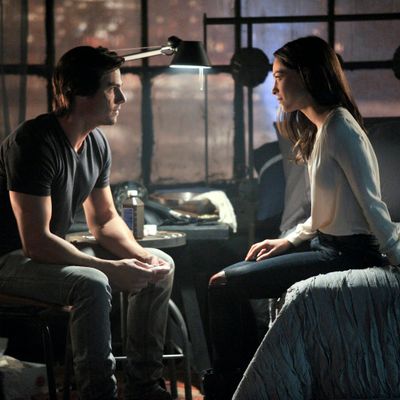
The reboot of Beauty and the Beast (CW, Thursdays, 9 p.m.), suffers from some of the same debilitating style tics that afflict other CW dramas ÔÇö blandly pretty actors; a choppy/glossy style ÔÇö but it takes its story seriously and thinks about the implications of what itÔÇÖs showing us. Because the show has a female lead and is built around themes coded as ÔÇ£girl stuffÔÇØ (romance, fairy-tale gender archetypes), itÔÇÖs likely to be written off as minor network fluff, but itÔÇÖs got more on the ball than the mostly brutal reviews suggest (ÔÇ£laughably bad,ÔÇØ one colleague calls it).
The original fairy tale yielded a lot of tonally diverse adaptations, including Jean CocteauÔÇÖs dream-signifier-packed 1946 feature, DisneyÔÇÖs 1991 animated musical comedy, and the 1987-1990 CBS show that inspired this new take; the latter, which starred Linda Hamilton as a district attorney and Ron Perlman as her sewer-dwelling guardian, birthed an adoring cult whose lobbying helped get the show renewed despite weak ratings. All these versions shared certain thematic threads: the allure of a deep, true love that canÔÇÖt be consummated and the ways in which ancient psychological baggage of femaleness and maleness encumber even modern grown-ups who think theyÔÇÖre beyond all that. The CWÔÇÖs new version plugs into these themes, too. Their primordial power carries the showÔÇÖs pilot through its rough patches. DonÔÇÖt get me wrong: Beauty and the Beast is no gem ÔÇö not yet, anyway. But thereÔÇÖs potential here.
Kristin Kreuk plays the heroine, Catherine ÔÇ£CatÔÇØ Chandler. We first meet her in a flashback. ItÔÇÖs 2003. SheÔÇÖs working as a bartender in New Jersey. One night after closing, she has car trouble and phones her mother for a jump-start, and minutes after MomÔÇÖs arrival, two men drive up and shoot her dead. Catherine escapes into the nearby woods and is about to be murdered when a mysterious shape swoops in and rips the two killers apart. The story picks up in the present day: Catherine is a New York City police detective investigating a womanÔÇÖs death in a ritzy hotel. The victim might have been murdered with poison, and thereÔÇÖs unaccounted-for DNA on her corpse belonging to one Vincent Keller (Jay Ryan), a Manhattan ER doctor who enlisted in the Army after 9/11, served in Afghanistan, and has been listed as dead since 2002.┬á
I donÔÇÖt want to spoil too much of Cat and VincentÔÇÖs intertwined backstories, since the pilot spends so much time untangling them; if you plan on watching the pilot anyway, you should probably save the rest of this review for later. (Yes, thatÔÇÖs a spoiler alert.)
Suffice it to say thereÔÇÖs a deep connection between them; that Vincent is a Samaritan who was trying to save the dead woman and has performed similar acts of heroism for nearly a decade; that he lives off-grid in a warehouse with his best friend, a scientist whoÔÇÖs trying to find a cure for his condition; and that said condition was foisted on him during his stint in Afghanistan.┬á
None of this is narrative wheel-spinning. ItÔÇÖs germane to the showÔÇÖs themes. Beauty and the Beast lacks finesse, but it isnÔÇÖt afraid to dive headfirst into gender archetypes and situate them in the modern world. Cat is never more traditionally ÔÇ£girlyÔÇØ than when Vincent is setting her heart aflutter or saving her from harm, but KreukÔÇÖs conflicted expressions confirm that the heroine isnÔÇÖt sure how to feel about all that. SheÔÇÖs elated, maybe smitten, then confused and perhaps slightly ashamed of herself for being elated and smitten. SheÔÇÖs a contemporary professional woman, so this mix of reactions makes sense. Cat is elegantly beautiful (in addition to her acting credits, Kreuk was the longtime face of Neutrogena), her look and demeanor coded as ÔÇ£conventionally feminine,ÔÇØ but she also packs a gun and works in a macho profession whose brutal hours make it tough to keep a boyfriend. (In an early scene, Cat discovers that her beau is tired of playing second fiddle to her career and has taken up with someone else; sheÔÇÖs aghast but recovers quickly, reports him for pot possession, and struts off with an eff-you grin.)
VincentÔÇÖs even more tortured and self-loathing. The military appears to have infected him with an equivalent of the ÔÇ£rage virusÔÇØ from 28 Days Later, and he seesaws between sweetness and terrifying anger, even when heÔÇÖs opening his heart to Cat. Between his empathy, chivalrous impulses, and status as virtual prisoner (heÔÇÖs basically trapped in that warehouse, his version of the castle from the original fairy tale), Vincent seems too sensitive, too stereotypically womanlike, to pass muster as a macho man, at least by todayÔÇÖs cartoonish standards of ÔÇ£hardness.ÔÇØ But heÔÇÖs a fearsome soldier whose scarred face is an outward signifier of his combat trauma. Those two aspects, romantic tenderness and controlled bloodlust, give the character a schizoid aspect, nicely articulated via RyanÔÇÖs brute-on-the-edge-of-tears voice. The pilot brings Cat face-to-face with the dark side of romance. The murder mystery centers on a manipulative relationship in which a man exploits his mateÔÇÖs happily-ever-after fantasies while secretly satisfying his urge to rut. The guy is a knave posing as a prince. HeÔÇÖs surrounded himself with a harem, all of whom have been suckered into thinking theyÔÇÖre his one true princess.
This is potent stuff. Beauty and the BeastÔÇÖs pilot is rarely more than competent, sometimes stubbed-toe clumsy. But if it can hang around for a while, devise a style that matches its story, and tap its starsÔÇÖ sincerity, it could become a cult hit: perpetually underrated but loved.


